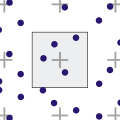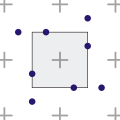
Rendering or image synthesis is the process of generating a photorealistic or non-photorealistic image from a 2D or 3D model by means of a computer program. The resulting image is referred to as the render. Multiple models can be defined in a scene file containing objects in a strictly defined language or data structure. The scene file contains geometry, viewpoint, texture, lighting, and shading information describing the virtual scene. The data contained in the scene file is then passed to a rendering program to be processed and output to a digital image or raster graphics image file. The term "rendering" is analogous to the concept of an artist's impression of a scene. The term "rendering" is also used to describe the process of calculating effects in a video editing program to produce the final video output.

"Jaggies" is the informal name for artifacts in raster images, most frequently from aliasing, which in turn is often caused by non-linear mixing effects producing high-frequency components, or missing or poor anti-aliasing filtering prior to sampling.

In computer graphics, rasterisation or rasterization is the task of taking an image described in a vector graphics format (shapes) and converting it into a raster image. The rasterized image may then be displayed on a computer display, video display or printer, or stored in a bitmap file format. Rasterization may refer to the technique of drawing 3D models, or the conversion of 2D rendering primitives such as polygons, line segments into a rasterized format.
In digital signal processing, spatial anti-aliasing is a technique for minimizing the distortion artifacts (aliasing) when representing a high-resolution image at a lower resolution. Anti-aliasing is used in digital photography, computer graphics, digital audio, and many other applications.

In signal processing and related disciplines, aliasing is the overlapping of frequency components resulting from a sample rate below the Nyquist rate. This overlap results in distortion or artifacts when the signal is reconstructed from samples which causes the reconstructed signal to differ from the original continuous signal. Aliasing that occurs in signals sampled in time, for instance in digital audio or the stroboscopic effect, is referred to as temporal aliasing. Aliasing in spatially sampled signals is referred to as spatial aliasing.
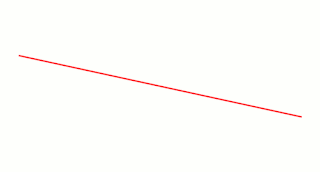
Xiaolin Wu's line algorithm is an algorithm for line antialiasing.

Subpixel rendering is a method used to increase the effective resolution of color matrix displays, such as LCD monitors. It takes advantage of the fact that each pixel is composed of individually addressable red, green, and blue components adjacent on the display matrix, called subpixels, and uses them as rendering units instead of pixels. Subpixel rendering is primarily used for text rendering on standard DPI displays, and isn't as useful for high DPI displays that can natively produce smoother images. Despite the inherent color anomalies, it can also be used to render general graphics.
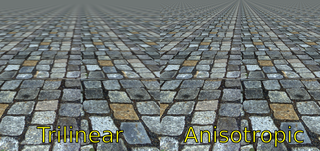
In 3D computer graphics, anisotropic filtering is a method of enhancing the image quality of textures on surfaces of computer graphics that are at oblique viewing angles with respect to the camera where the projection of the texture appears to be non-orthogonal.

In scientific visualization and computer graphics, volume rendering is a set of techniques used to display a 2D projection of a 3D discretely sampled data set, typically a 3D scalar field.
In computer graphics, texture filtering or texture smoothing is the method used to determine the texture color for a texture mapped pixel, using the colors of nearby texels.
The Saffron Type System is a system for rendering high-quality scalable type on digital displays. It was developed by Mitsubishi Electric Research Laboratories, and is built on a core of adaptively-sampled distance field (ADF) technology. Saffron has been licensed to Adobe and Monotype and is shipping in numerous products such as the Adobe Flash Player and Amazon Kindle. Saffron has been implemented in both software and hardware.
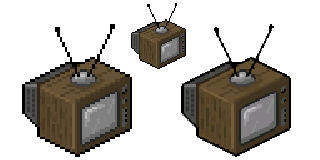
In computer graphics and digital imaging, imagescaling refers to the resizing of a digital image. In video technology, the magnification of digital material is known as upscaling or resolution enhancement.
Multisample anti-aliasing (MSAA) is a type of spatial anti-aliasing, a technique used in computer graphics to remove jaggies.

Texture compression is a specialized form of image compression designed for storing texture maps in 3D computer graphics rendering systems. Unlike conventional image compression algorithms, texture compression algorithms are optimized for random access.
Temporal anti-aliasing (TAA) is a spatial anti-aliasing technique for computer-generated video that combines information from past frames and the current frame to remove jaggies in the current frame. In TAA, each pixel is sampled once per frame but in each frame the sample is at a different location within the pixel. Pixels sampled in past frames are blended with pixels sampled in the current frame to produce an anti-aliased image. Although this method makes TAA achieve a result comparable to supersampling, the technique inevitably causes ghosting and blurriness to the image.
Anti-aliasing may refer to any of a number of techniques to combat the problems of aliasing in a sampled signal such as a digital image or digital audio recording.
Fast approximate anti-aliasing (FXAA) is a screen-space anti-aliasing algorithm created by Timothy Lottes at Nvidia.
Gradient domain image processing, also called Poisson image editing, is a type of digital image processing that operates directly on the differences between neighboring pixels, rather than on the pixel values. Mathematically, an image gradient represents the derivative of an image, so the goal of gradient domain processing is to construct a new image by integrating the gradient, which requires solving Poisson's equation.
In computer graphics, A-buffer, also known as anti-aliased, area-averaged or accumulation buffer, is a general hidden surface mechanism suited to medium scale virtual memory computers. It resolves visibility among an arbitrary collection of opaque, transparent, and intersecting objects. Using an easy to compute Fourier window, it increases the effective image resolution many times over the Z-buffer, with a moderate increase in cost.
This is a glossary of terms relating to computer graphics.







